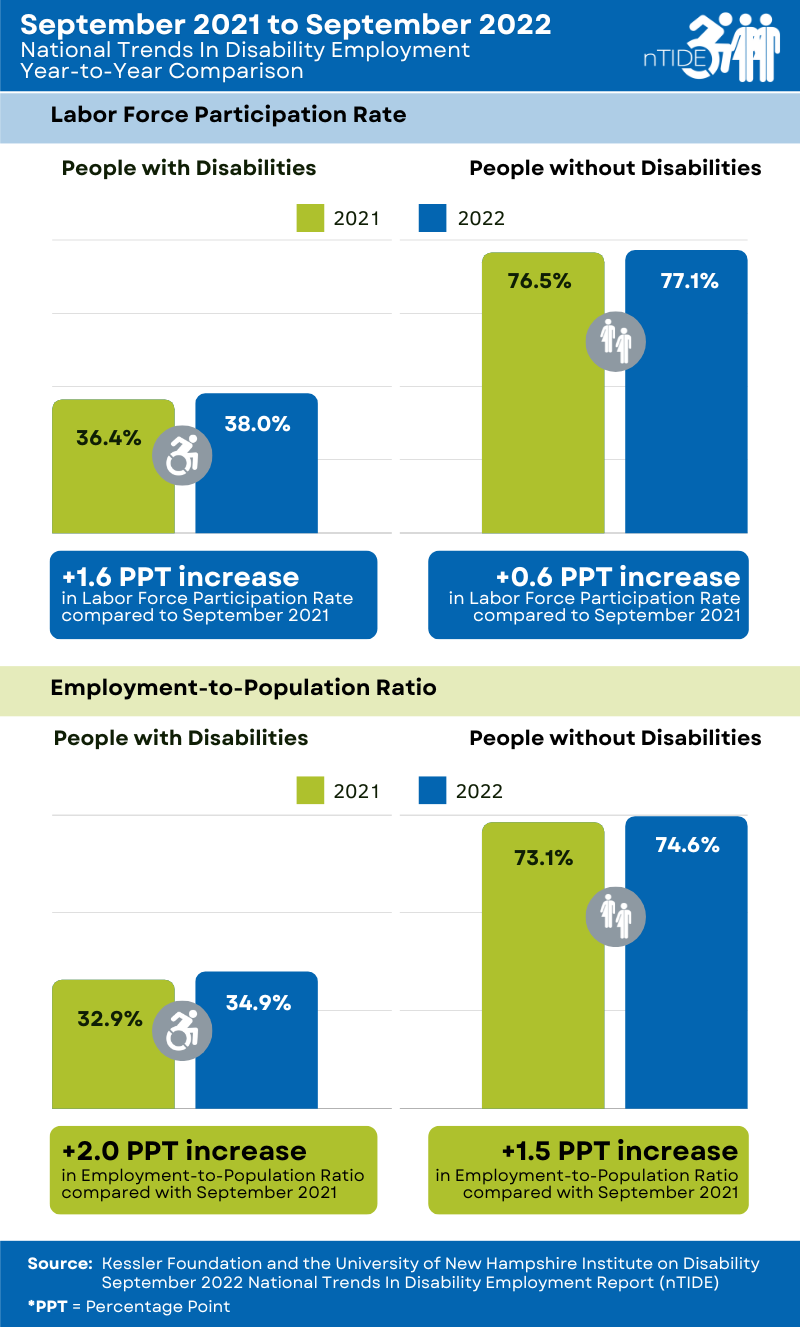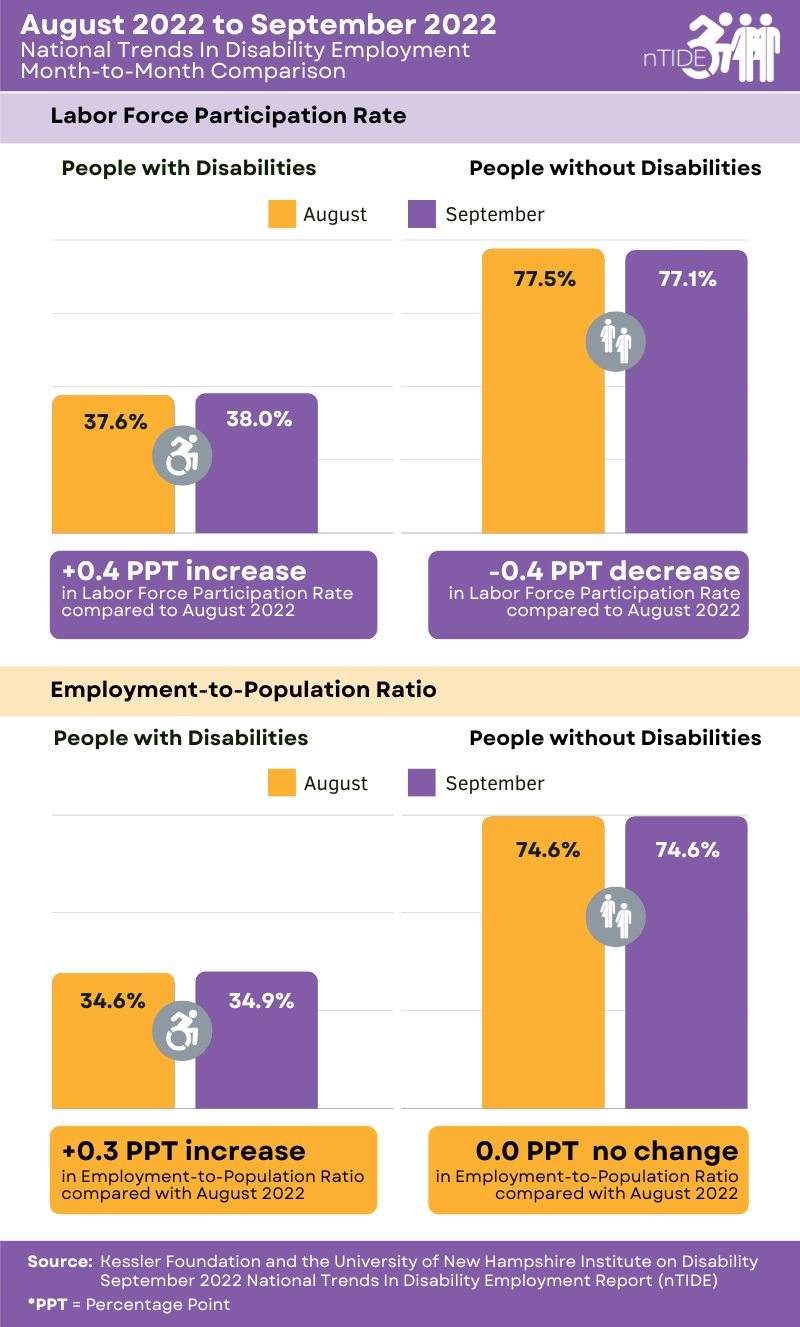Although our regular broadcast of the nTIDE webinar on 10/7 was canceled, you can still access the National Trends in Disability Employment (nTIDE) monthly Jobs Report written in collaboration by the Kessler Foundation and the University of New Hampshire. Please note, the live webinar event was cancelled so a recording is not available.
nTIDE September 2022 Jobs Report: People with disabilities continue to enter labor force, foregoing Great Resignation
National Trends in Disability Employment (nTIDE) – Issued semi-monthly by Kessler Foundation and the University of New Hampshire
East Hanover, NJ – October 7, 2022 – Employment numbers were positive for people with disabilities, who continued to enter the labor force in September while labor force participation remained unchanged for people without disabilities, according to today’s National Trends in Disability Employment – Monthly Update (nTIDE), issued by Kessler Foundation and the University of New Hampshire’s Institute on Disability (UNH-IOD). nTIDE experts also noted that the employment-to-population ratio for people with disabilities continued to trend above previous historic highs.
Month-to-Month nTIDE Numbers (comparing August 2022 to September 2022)
In the U.S. Bureau of Labor Statistics (BLS) Jobs Report released today, the employment-to-population ratio for people with disabilities (ages 16-64) increased from 34.6 percent in August to 34.9 percent in September (up 0.9 percent or 0.3 percentage points). For people without disabilities (ages 16-64), the employment-to-population ratio was unchanged at 74.6 percent in September (0 percent or 0 percentage points). The employment-to-population ratio, a key indicator, reflects the percentage of people who are working relative to the total population (the number of people working divided by the number of people in the total population multiplied by 100).
Month-to-Month nTIDE Numbers (comparing July 2022 to August 2022)
In the U.S. Bureau of Labor Statistics (BLS) Jobs Report released today, the employment-to-population ratio for people with disabilities (ages 16-64) increased slightly from 34.4 percent in July to 34.6 percent in August (up 0.6 percent or 0.2 percentage points). For people without disabilities (ages 16-64), the employment-to-population ratio decreased slightly from 75.0 percent in July to 74.6 percent in August (down 0.5 percent or 0.4 percentage points). The employment-to-population ratio, a key indicator, reflects the percentage of people who are working relative to the total population (the number of people working divided by the number of people in the total population multiplied by 100).
“The employment-to-population ratio for people with disabilities has remained steadily above historic highs for the past twelve months,” said John O’Neill, PhD, director of the Center for Employment and Disability Research at Kessler Foundation. “This is encouraging for now,” he added, “considering the growing concerns about recession.”
Findings were similar for August’s labor force participation rate. For people with disabilities (ages 16-64), the labor force participation rate increased slightly from 37.3 percent in July to 37.6 percent in August (up 0.8 percent or 0.3 percentage points). For people without disabilities (ages 16-64), the labor force participation rate decreased slightly from 77.8 percent in July to 77.5 percent in August (down 0.4 percent or 0.3 percentage points). The labor force participation rate is the percentage of the population that is working, not working, and on temporary layoff, or not working and actively looking for work.
“The lack of movement in these labor market indicators may be an early sign of the impact of anti-inflationary measures taken by the U.S. Federal Reserve to slow the economy,” remarked Andrew Houtenville, PhD, professor of economics and the research director of the UNH-IOD. “Historically, impacts on the labor market lag behind movements in economic growth such as movement in gross domestic product (GDP). We would not expect to see large changes in employment and labor force participation until after we see declines in economic growth,” explained Dr. Houtenville.
“The trend in the employment-to-population ratio for people with disabilities continues for the thirteenth consecutive month at levels consistently above the historic highs seen in 2008,” said John O’Neill, PhD , director of the Center for Employment and Disability Research at Kessler Foundation. “This is encouraging for now considering that the Federal Reserve continues to raise interest rates to dampen economic growth, which will most likely curtail future hiring.”
Findings were similar for September’s labor force participation rate. For people with disabilities (ages 16-64), the labor force participation rate increased from 37.6 percent in August to 38.0 percent in September (up 1.1 percent or 0.4 percentage points). For people without disabilities (ages 16-64), the labor force participation rate decreased slightly from 77.5 percent in August to 77.1 percent in September (down 0.5 percent or 0.4 percentage points). The labor force participation rate is the percentage of the population that is working, not working, and on temporary layoff, or not working and actively looking for work.
“As a group, people with disabilities are not partaking in the Great Resignation,” remarked Andrew Houtenville, PhD, professor of economics and the research director of the UNH-IOD. “They are entering or reentering the labor force. While this could be seen as a positive sign of a more inclusive work force, it could be signaling the need to boost household income in the face of rising prices,” explained Dr. Houtenville.
Year-to-Year nTIDE Numbers (Comparing September 2021 to September 2022)
The employment-to-population ratio for working-age people with disabilities increased from 32.9 percent in September 2021 to 34.9 percent in September 2022 (up 6.1 percent or 2 percentage points). For working-age people without disabilities, the employment-to-population ratio also increased from 73.1 percent in September 2021 to 74.6 percent in September 2022 (up 2.1 percent or 1.5 percentage points).
Similarly, for people with disabilities (16-64), the labor force participation rate increased from 36.4 percent in September 2021 to 38.0 percent in September 2022 (up 4.4 percent or 1.6 percentage points). For people without disabilities (ages 16-64), the labor force participation rate also increased from 76.5 percent in September 2021 to 77.1 percent in September 2022 (up 0.8 percent or 0.6 percentage points).

In September, among workers ages 16-64, the 5,842,000 workers with disabilities represented 3.9 percent of the total 148,000,000 workers in the U.S.
IMPORTANT: No Lunch & Learn Webinar on October 7! Join us for our next webinar on October 21.Register now for this Special Edition webinar: “Effects of COVID-19 Pandemic on Supervisor Perspectives: Comparing the workplaces of 2022 and 2017,” with experts from Kessler Foundation, UNH-IOD, and SHRM Foundation. Learn first-hand about top-line findings from our latest survey: 2022 Kessler Foundation National Employment and Disability Survey: Supervisor Perspectives, which offers new insights into the effects of the COVID-19 pandemic on the experiences of employees with disabilities.
NOTE: The statistics in the nTIDE are based on Bureau of Labor Statistics numbers but are not identical. They are customized by UNH to combine the statistics for men and women of working age (16 to 64). nTIDE is funded, in part, by grants from the National Institute on Disability, Independent Living and Rehabilitation Research (NIDILRR) (90RT5037) and Kessler Foundation.
About the Institute on Disability at the University of New Hampshire
The Institute on Disability (IOD) at the University of New Hampshire (UNH) was established in 1987 to provide a university-based focus for the improvement of knowledge, policies, and practices related to the lives of persons with disabilities and their families. For information on the NIDILRR-funded Research and Training Center on Disability Statistics, visit ResearchOnDisability.org.
About Kessler Foundation
Kessler Foundation, a major nonprofit organization in the field of disability, is a global leader in rehabilitation research that seeks to improve cognition, mobility, and long-term outcomes – including employment – for people with neurological disabilities caused by diseases and injuries of the brain and spinal cord. Kessler Foundation leads the nation in funding innovative programs that expand opportunities for employment for people with disabilities.

